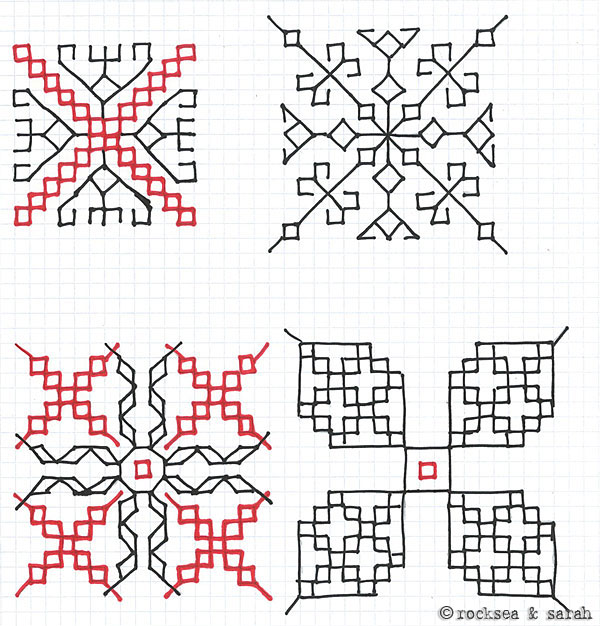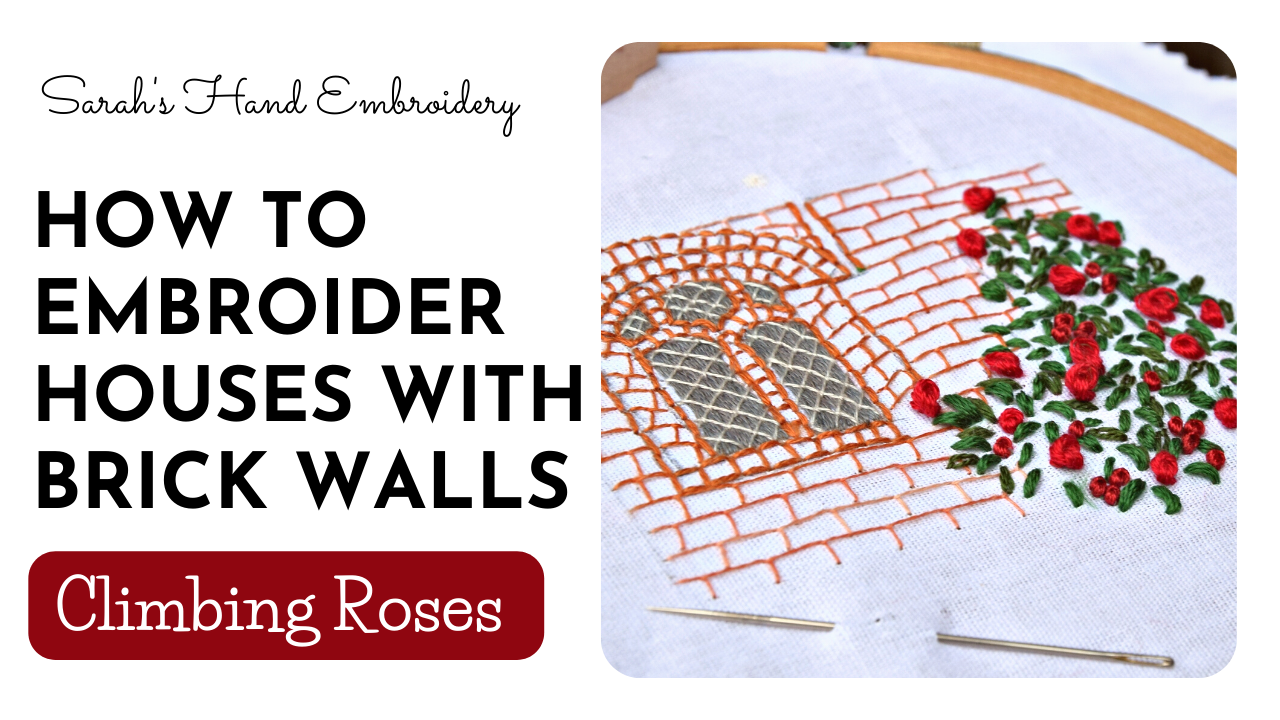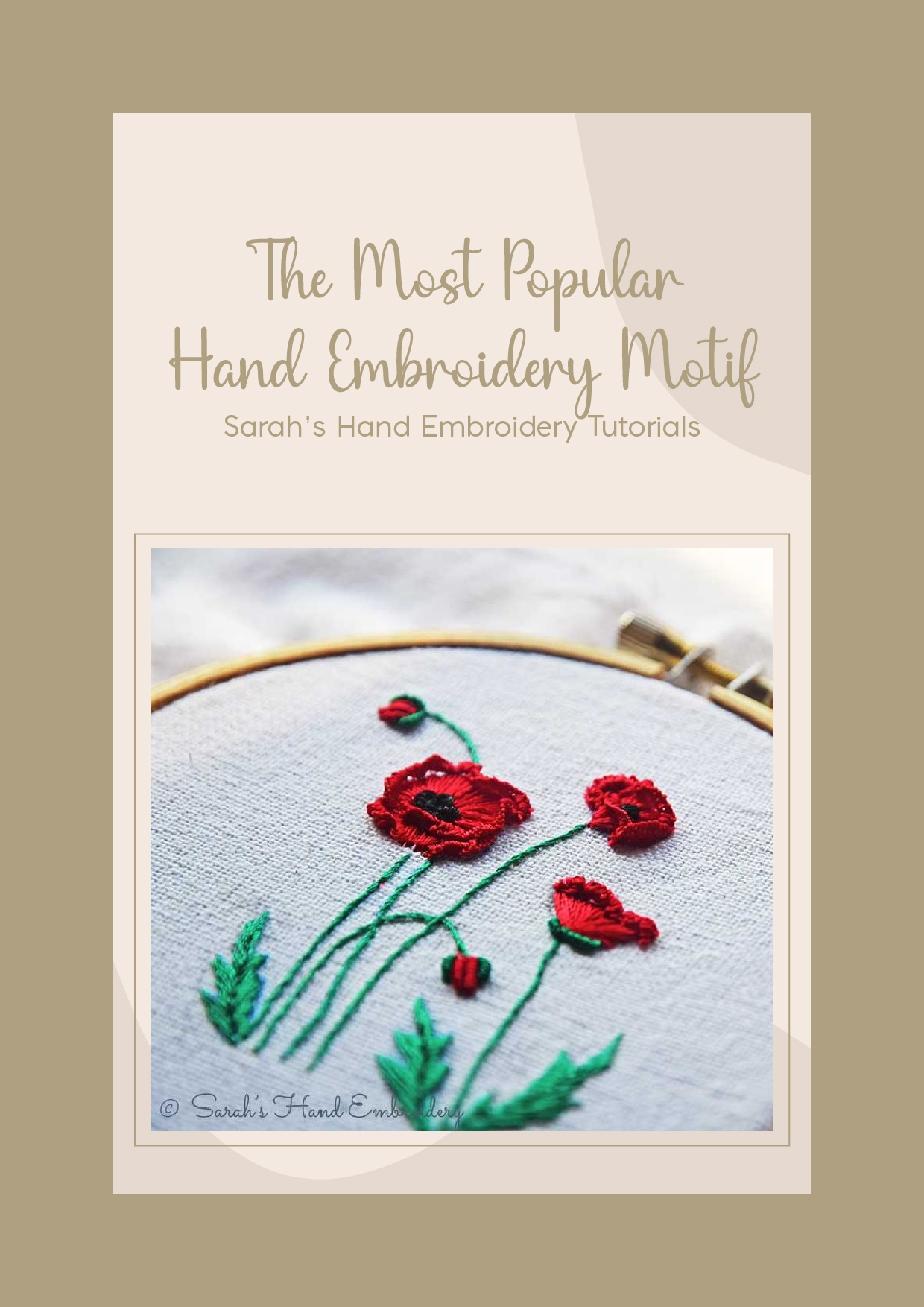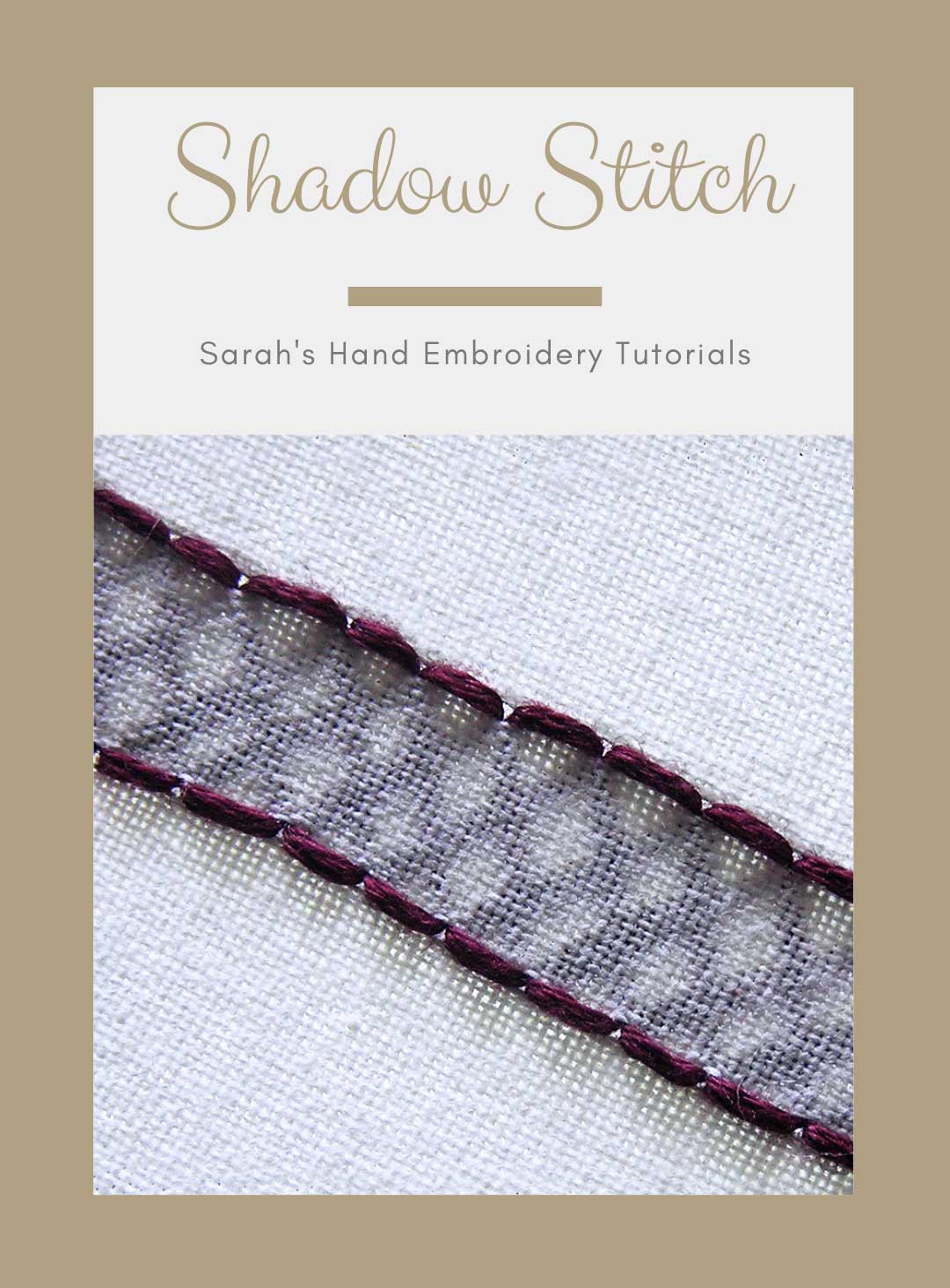How to make patterns in Kasuti
This lesson will deal with the basics of Kasuti. It will give an overview of what stitches are used and how to stitch them. It will also deal with some basic technical aspects required to design a pattern and how to transfer the designs to the fabric.
Stitches used in Kasuti
Kasuti uses four kinds of stitches for its embroidery. Though three of these four stitches are reversible, Kasuti itself is not essentially a reversible form of embroidery. The use of all these four stitches in a single pattern is not a must.
The red lines represent stitches made one way (left to right), and the blue lines represent stitches made on the return journey. Click on the stitch names given in the description to go to their tutorials.
1. Ganti or Gavanti
 |
Ganti means knot. It is the typical Holbein stitch style done in a straight line, either vertically or horizontally or even diagonally. This stitch is reversible and shows up the same on the front and back of the fabric. |
2. Muragi
 |
Muragi means twisted. It is a variation of Holbein stitch. It has a ‘zig-zag’ nature. This can be made vertically, horizontally, or diagonally. The diagonal pattern, with a ladder-like appearance, is used most popularly. Muragi is also used to fill up patterns. This stitch is reversible and shows up the same on the front and reverse of the fabric. |
3. Neygi or Negi
 |
Neygi means to weave. It is the typical pattern darning stitch. It uses running stitch to make patterns and gives a weaved effect. Neygi is now no longer popularly used in Kasuti hand embroidery, thanks to the weaving machines that do the job. This stitch is reversible, but they tend to be like mirror images of each other. |
4. Menthi
 |
Menthe means fenugreek. It uses the typical cross stitch to fill in the patterns or motifs. This stitch is not reversible. While it shows up like cross fillings on the front of the fabric, the reverse will be just vertical or horizontal, or even diagonal lines. |
Designing the patterns
1. Enlarging and shrinking patterns
 |
It is easy to enlarge or shrink a pattern to suit our requirement, thanks to the geometrical nature of Kasuti.A very simple pattern has been used to illustrate this. Notice that each line in the second pattern is twice the length of the lines in the first pattern. So, my second pattern is double the size of the first pattern. Mathematically, I have used 1:2 proportion. Similarly, you can use any kind of proportion. This method can be used to shrink the pattern as well. |
2. Making borders from ‘buti’
 |
A ‘buti’ is a small single stand-alone pattern. Often, in Kasuti, many ‘buti’ is used to sprinkle over a large area. We can also make borders from ‘buti’. |
 |
The illustration shows how a series of ‘buti’ can be connected to make a border. You can use your imagination to use patterns to connect the ‘buti’. The ones shown here is just examples for you to get an idea. |
 |
|
 |
3. Making corners from borders
 |
 |
 |
 |
| Creating a neat corner is important for Kasuti. Here are some examples of how we create borders from the earlier illustrated buti borders. | |
Transferring the design
We have to keep in mind that Kasuti is a form of counted thread work that can easily be done over even weave fabric today. We can do it over regular fabric too, but with some aid. The three ways of transferring designs from graph to fabric will be dealt with in the subsequent lessons.
1. Tracing from the graph paper
The designs can be traced using a tracing paper directly onto the cloth to be worked on. We need to be careful while stitching so that each corner of the stitch is neatly done and maintained.
2. Even weave cloth
Working on even-weave cloth does not require transferring of the design directly. The graph can be used as a referral to replicate the design onto the even weave cloth.
3. Voile net
This is a cloth net that is used as a replicate for an even weave cloth. We need to attach the net to the pain fabric to work on. The stitch can be now done over this net and cloth with the design on the graph as a referral to replicate. Once the design is done, the voile net can be carefully cut and pulled out leaving the stitched pattern on the plain fabric.
Reference: KASUTI skill training presentation by Avni Varia to Sampark.
Next, go to the other detailed Kasuti lessons:





 Sarah has been researching and sharing hand embroidery lessons for over 17 years, making it accessible to everyone around the globe.
Sarah has been researching and sharing hand embroidery lessons for over 17 years, making it accessible to everyone around the globe.





Your site came up on searching about kasuti embroidery. It definitely has great information related this embroidery. What kind of thread is used for this embroidery? The ones I own is single thread and does not seem like regular embroidery thread. I tried Perle cotton thread too but the tautness that I see in the ones I have ..could not be achieved. It would be helpful if you can let me know where I can find that specific thread. It seems like single strand cotton thread.
Hi Chetana,
Thanks. I have used a thick perle cotton (white on pink pattern) that I had picked from Italy. It is about the size of 5 strands of regular embroidery floss. The ones found in India is thicker, about the size of 3 strands of embroidery floss. It is great for kasuti. I have used 3 strands of regular embroidery for yellow on green. But, original kasuti uses 1 strand with the patterns scaled down. In hope this helps gives you an idea. Don’t hesitate to ask more. 😊
Hi Sarah, from where can I buy this kasuti net in Mumbai? Alternatively, would you know if I can buy this online? Pl let me know. Would be very grateful. Thanks and regards, Vanessa
Hi Vanessa,
I am not sure where to buy waste canvas in Mumbai. You would find it in shops or areas that sell embroidery materials. Yes, I did see it on amazon…slightly expensive though. I am sure there are cheaper options if you buy it directly from shops. Do inform us if you find it successfully in Mumbai. Thank you.
Dear Sarah,
Your Tutorial is very easy to follow.can you tell me what is the best length for a single kasuti stitch? I Can draw diagrams using graph
Hi Vijayalakshmi,
Thank you. Kasuti patterns are generally small. Each stitch would be 0.3 to 0.5 cms in length. But, you can always use a size you feel comfortable with.
Thank you sarah
You have raised the same query I had..and about graph also.one thing I wanted to know is where to buy the net .I just copied from graph paper ..regards to you.
Sara is such an excellent teacher.evrything explained so well.thanks to her iam doing this at my seventies,,
What fabric do you use for the Kasuti.
Hi Linda,
Kasuti is done over silk or cotton fabric. Since the patterns are geometrical, a waste canvas is used to work the embroidery.
Dear Sarah,
I love the Kasuti work. I read it in the DH Spectrum, magazine section. I want to learn to do the designs. Please help me to find where I can get the help from. All the best to you; I am looking forward to hearing from you –
regards – Beatrice.
Dear Beatrice,
I am quite not sure where would you learn to do the designs of Kasuti.
However, if you figure out the basic logic behind the designing, you can try to learn on your own.
Check out a few designs and how they work, and you should be able to figure out how you can create your own templates.
Hello Sarah,
I would like to give my daughter a kasuti saree as part of her trousseau. Can you recommend someone who would do the kasuti work.
Would greatly appreciate your help.
Namrata
Loved you tutorials Sarah. I have Pinned some of them.
Sarah can you teach me traditional Syrian Catholic embroidery of kerala?
Your site is just wonderful – thanks and God Bless!
Dear Sarah
It was very nice to see your kasuti tutorials
I have started learning it
the designs are pretty as well
I will posting some of my embroidery when my work will be neat as yours
Thank you so much
Gouri
I am good in hand embroidery can I start a class at my own .
Will you help me?
thank u so much…….it’s very useful to me
Hi Sarah,
You are doing a great job. Could you post how to do zardosi work on saree blouse.
Hello Sarah! I love your blog! I don´t do much embroidery, but every spring, when there is more light, I need to start a new project.
Kasuti has a northern relative, the Karelian “etupistokirjonta”, used in ritual towels, “käspaikka”.
Here you find a example.
Dear Katarina,
Thank you so much for this invaluable information. I am truly baffled at the similarities that both forms of embroideries have! Though I related Kasuti technically to the Blackwork as its western counter part, I never knew that it also had a more similar cousin in Finland. In fact, it is easy to mistaken between both if not mentioned!
I would like to learn more about it. Is it possible for you to tell me if the pattern in the towel (in the example) mean anything? I mean, if the bird is of a particular kind and if the pattern in the center represents anything? And, what do you use this towel for, since you said it is a ritual towel.
Many thanks. 🙂
Hi sarah , good lessons from today i am going to learn kasuti thanku very much
hi sarah,
i thought i know how to do kasuti embroidery but i am definitely wrong. Your tutorials are really amazing. please be continue to do so that i can re-learn the kasuti work. hihihi.
I love you very much.I am in pondy studying in X std.We had got an assignment to do embroidery. I don’t know anything.Then I found YOU.It was very easy to learn. THANK YOU SO MUCH To help me. I LOVE U.
Sara I have done a small project on kasuti. The motif is here:

I have blogged about it here:
http://www.shamiatcraft.blogspot.in/2012/10/a-small-project-on-kasuti.html
Thanks for being an inspiration to me.
Dear Shami,
It is nice to see how you are enjoying doing Kasuti. A very nice pattern. Thanks for sharing. 🙂
Hi sarah
Started learning Kasuti. My first trial piece is here:

Got this design thru Mridulas embroidery book on kasuti. But for every embroidery my first teacher is you.
I have given post in my blog also.
shamiatcraft.blogspot.in/2012/08/kasuti-embroidery-fridge-handle
Have a look.
Feel free to drop a comment as it boost me up a lot.
Shami Immanuel.
Dear Shami,
Thanks for sharing this pattern. You have done a neat work. 🙂
Hey what’s dat fabric u hv worked on??
HI Sarah
Great . the tutorials were a refersh course for me, as I did this in India Bangalore and today i saw your website and the course and the designs are very helpful to me i shall use them and let you know. If you have any more designs please sent them to my email given so that i can do them, as i do not have any designs with me as I am in New YOrk. thanks sudha
Dear Sudha,
If there are more designs, I will upload it here, so you can print them out. Else, you can try out some designs on your own. Use a checkered notebook to make these designs and it can be transfered to the fabric you wish to embroider on. Or, try a google search for more idea on kasuti designs.
Hi Sarah
I purchased the Aida net cloth here on this fabric can I do the kauthi stich keep the pattern as reference. wanted your suggestions. Any way this week I shall try the same too.
thanks sudha
HI Sarah
Do you have any designs on Kutch work or pattens or lessons on it. As I have done both Kasuthi and Kutch In India Bangalore and it has been a long time so just want to refresh b4 I start .
sudha
Very nice and thank you for the step by step instructions
Happy that these pages are helpful to you, Anjali. 🙂
dear sarah mam,
i am very thankful to u for the way u teach kasuti
Dear Ajitha,
It is a delight to know that you have enjoyed our Kasuti lessons. 🙂 If you have done any work on Kasuti, do upload it as a sample.
Beautiful lessons, great pics!! Was looking out for this info for a long time. Thanks.
Sangeetha,
🙂 . Happy that you enjoyed learning from our pages.
Hello Sarah i was lucky to find your tutorials.I found it very useful.Thanks for such a beautiful illustration.
Thanks Sandhya. I am happy that you enjoyed the lessons. 🙂
Yeah Sarah, Kasuti looks like a simple double running or Holbein stitch, but working it on cloth counting the threads… is not easy.
I have a lot of Kasuti samples (will add on my blog soon). Especially I have one, where the gap between stitch is just about 1 mm. Uploading one such design in my blog – I just can’t imagine how could they over work such a minute design that too on a black cloth
Check out this link
Wow, the sample picture of the work in your blog looks good, and it is diffiuclt to imagine how much effort must have gone into it. Thanks for sharing it. 🙂
In traditional kasuti, it’s more like the smaller the gap between each stitch, the better. Like you could have around 25 stitches to an inch (especially in Negi). Or stitches with a gap of 2 or 3mm. It’s traditionally done, counting the Warp & Weft threads, ideally done in sunlight during Summer.
Dear Shilpa,
This is good information. Thank you. 🙂
Looks like traditionally, Kasuti was pretty painstaking.
Hii
thankyou for your beautiful tutorials, I wish you put up some of your works too in the page so that we can admire ur work and get some inspiration!
Thanks for ur time
Dear Sham,
Thanks a lot. Yes, I will put up some of my works too as soon as I get a chance. 🙂
Right now, researching and working on stitch tutorials takes up most of the time.
Dear Sarah,
So good of you to work on putting up this site. On my recent trip to Karnataka, I learnt quite a few designs in Kasuti but I misplaced my pieces. I was desperately looking for some patterns. It was a boon to find your basic tutorials and the patterns. Thanks.
Dear Anasuya,
Thank you. I am so happy that you found the tutorials useful. I would like to put up patterns for practice once conditions permit. It might take some time though.
Dear Sarah,
I feel lucky that I came across your lessons. I am very much interested in Indian hand embroidery, even though Iam in an unrelated profession. In fact my profession also involves lot of stitches!!!!
Thank you very much for your illustrative lessons on Kasuthi
love
Annie
Dear Annie,
You gave me a laugh! Sure, your profession does involve a lot of stitches and can practice some of what you learn here over there too. 😛 No one would deny a designer stitch!
Glad that you liked the lessons. 🙂
Best wishes.
thank you! I have got very important information regarding kasuti which i was searching from long time.
Happy to know that our page on Kasuti helped, Smruti. Enjoy! 🙂